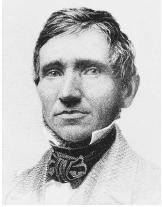Charles Goodyear

AMERICAN INVENTOR
1800–1860
Charles Goodyear was born in New Haven, Connecticut, on December 29, 1800. Goodyear began his work on rubber in 1834, when rubber from Brazilian trees ( Hevea brasiliensis ) was first being imported to the United States in large quantities. He approached a rubber goods manufacturer with an idea for a valve for an inflatable life buoy, but was advised that the company's own products were failing because of the material's inherent flaws. Although it had outstanding qualities, it turned brittle and hard at low temperatures, and worse, into a gooey mass during warm weather.
Goodyear was determined to solve the problems inherent in natural rubber. With no formal training in chemistry, his work was based on trial and error, experimenting with different methods of processing and additives such as magnesia. The solution he discovered resulted partly from serendipity and partly from constant work.
The breakthrough came in 1839 while Goodyear was exhibiting his most recent samples at a general store in Woburn, Massachusetts. When he accidentally dropped a piece on a hot stove, it burned, but the uncharred part was transformed into a smooth, firm material that was not affected by high or low temperature. The additive in the sample was sulfur, but it took Goodyear several months to determine the right combination of heat, pressure, and sulfur to produce a stable compound. He found that the best material was produced when the compound was steam-heated under pressure at 120°C (248°F) for four to six hours. Its first commercial use was as elastic thread in men's shirts.
Goodyear vigorously promoted his product, but was forced to spend large sums of money defending his patent. In Britain, Thomas Hancock had received a patent for vulcanized rubber (after Vulcan, the Roman god of fire) a few months before Goodyear applied for his. Although Hancock offered to share his royalties, Goodyear took his claim of sole ownership to court and lost. He also lost his French patent, although he was eventually awarded the Cross of the Legion of Honor by Napoléon III for his important work.
Goodyear invented a material that would eventually be used in thousands of ways and opened the door for a huge industry. Today there is one rubber tree for every two people on Earth. Despite this, he died destitute in New York on July 1, 1860. Although the Goodyear Tire and Rubber Company was named in his honor, Goodyear's descendants had little to do with the rubber industry after his death.
SEE ALSO Polymers, Natural ; Rubber .
Andrew Ede
Bibliography
Slack, Charles (2002). Noble Obsession: Charles Goodyear, Thomas Hancock, and the Race to Unlock the Greatest Industrial Secret of the Nineteenth Century. New York: Hyperion.
Internet Resources
Goodyear Tire and Rubber Company. "Charles Goodyear and the Strange Story of Rubber." Available from http://www.goodyear.com/corporate/strange.html .
Comment about this article, ask questions, or add new information about this topic: